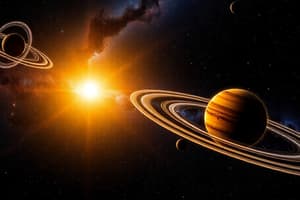Podcast
Questions and Answers
What is the distinctive feature of Venus's motion in the solar system?
What is the distinctive feature of Venus's motion in the solar system?
- Following a perfectly straight line
- Displaying retrograde motion (correct)
- Having the largest orbit
- Moving in a perfect circle
Which planet in our solar system is closest to the Sun?
Which planet in our solar system is closest to the Sun?
- Jupiter
- Mercury (correct)
- Neptune
- Uranus
What causes the distinct paths known as orbits followed by planets in our solar system?
What causes the distinct paths known as orbits followed by planets in our solar system?
- Gravitational interactions between planets (correct)
- Magnetic fields of the planets
- Friction with space particles
- Reflection of sunlight
Which celestial body is now classified as a dwarf planet in the solar system?
Which celestial body is now classified as a dwarf planet in the solar system?
What determines the shape of an orbit in the context of orbital motion?
What determines the shape of an orbit in the context of orbital motion?
What type of orbit is most commonly slightly eccentric due to variations in speed along the curve?
What type of orbit is most commonly slightly eccentric due to variations in speed along the curve?
Which description best fits a satellite moving around its primary in a slightly oval shape?
Which description best fits a satellite moving around its primary in a slightly oval shape?
According to Kepler's laws of planetary motion, what kind of orbits do all planets have?
According to Kepler's laws of planetary motion, what kind of orbits do all planets have?
What do Kepler's laws of planetary motion state about the relationship between orbital periods and average distances from the star?
What do Kepler's laws of planetary motion state about the relationship between orbital periods and average distances from the star?
In astronomy, studying solar system dynamics requires knowledge of:
In astronomy, studying solar system dynamics requires knowledge of:
Study Notes
Astronomy is a science that studies celestial objects and phenomena beyond Earth's atmosphere. It includes the study of planets within our own solar system, how they move in their respective orbits, and other astronomical phenomena such as galaxies and black holes. Here we will explore some key concepts related to astronomy, specifically focusing on the solar system and orbital mechanics.
Solar System
The solar system consists of the Sun, its eight planets, and various other smaller bodies like moons and asteroids. The planets follow distinct paths around the sun known as orbits, which are roughly elliptical rather than perfectly circular. These planetary orbits are influenced by gravitational interactions between planets, and by other factors like gravity from the Sun and dark matter. Each planet has its unique characteristics, with Mercury being closest to the Sun, Venus moving in retrograde motion, Mars having dust storms, Jupiter being the largest gas giant, Saturn displaying rings of ice particles, Uranus tilted sideways, Neptune furthest away from the Sun, and Pluto now classified as a dwarf planet.
Orbit
Orbit refers to the curved path followed by an object under the influence of another body's gravitational force. In the context of the solar system, it describes how planets, moons, meteoroids, spacecraft etc., revolve around the center of mass of the two bodies involved. The shape of an orbit depends on what type of motion is involved. A circular orbit is one where the speed and gravitational pull balance each other out. However, most orbits are slightly eccentric, meaning they have a slight oval shape due to variations in speed along the curve. A satellite, for example, might be moving in an elliptical orbit around its primary. Kepler's laws of planetary motion describe how planets move in their orbits based on their distance from the central star. These laws state that all planets have elliptical orbits with the same axis and that their orbital periods square with their average distances to the star.
In summary, astronomy involves studying both the broader universe and specific systems like our solar system. Within the latter, understanding solar system dynamics requires knowledge of planetary orbits - both the general concept and the intricacies of individual planets' paths around the Sun.
Studying That Suits You
Use AI to generate personalized quizzes and flashcards to suit your learning preferences.
Description
Explore key concepts in astronomy related to the solar system and orbital mechanics. Learn about the planets in our solar system, their unique characteristics, and how they move in their respective orbits. Understand the fundamentals of orbits, including circular and elliptical paths, gravitational interactions, and Kepler's laws of planetary motion.




